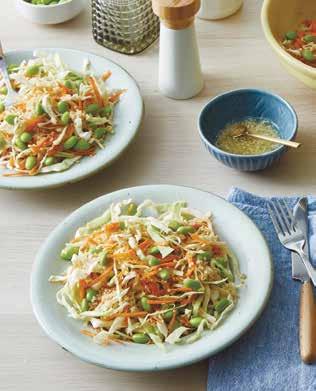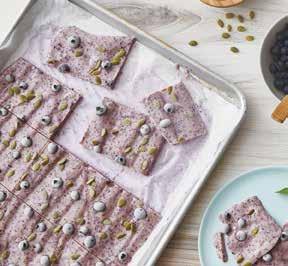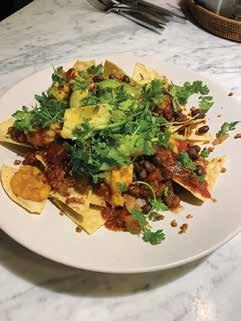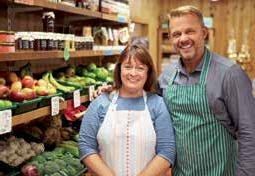
14 minute read
HEARTFELT EATING
conscious eating
Heartfelt Eating Best Foods for a Heart-Healthy Diet
Advertisement
by April Thompson
Hypertension affects nearly half of all Americans, increasing the risk for heart disease and stroke, the leading cause of death. We can help mitigate that risk and have a healthy “change of heart” by revamping our diets.
m.studio/Adobestock.com
While food fads are constantly changing, the basics of a heart-healthy diet have not, says Cheryl Strachan, a registered dietitian in Calgary, Canada, and founder of SweetSpotNutrition.ca. Strachan notes the Dietary Approaches to Stop Hypertension (DASH) diet has been used to help lower blood pressure and with other heart disease risk factors since its development in the 1990s. The DASH diet is rich in fruits, vegetables, whole grains, nuts, beans and low-fat dairy foods. While it includes lean meat, fish and poultry, it limits sugary foods and fatty meats.
The Mediterranean diet, says Strachan, is another proven regimen for heart health, citing a five-year Spanish study in The New England Journal of Medicine that found the incidence of cardiovascular events was 30 percent lower among participants on this diet, supplemented with extra-virgin olive oil or nuts, compared to those assigned a reduced-fat diet.
A Mediterranean diet doesn’t necessarily mean eating dishes specific to that region. “It’s the type of foods that matters: a largely plant-based diet focused on whole grains such as the bulgur in tabouli, legumes, nuts, seeds, olive oil and some animal products like fish, poultry and dairy,” says Strachan.
Michael Greger, a Seattle physician and author of the bestseller How Not to Die, disagrees that meat-based proteins have a place in a heart-healthy diet. “Only one way of eating has ever been proven to reverse heart disease in the majority of patients: a diet centered around whole-plant foods,” says Greger, adding that the most critical risk factor is elevated LDL cholesterol. “To drastically reduce LDL cholesterol levels, we need to drastically reduce our intake of trans fat, which comes from processed foods and naturally from meat and dairy; saturated fat, found mainly in animal products and junk foods; and playing a lesser role, dietary cholesterol, found exclusively in animal-derived foods, especially eggs.”
Michelle Routhenstein, a preventive cardiology dietitian and owner of Entirely Nourished, a nutrition counseling practice in New York City, likes to meet clients where they are rather than trying to force a drastic switch they can’t maintain. “Often, people get very broad advice, like ‘Adopt a
plant-based diet,’ but when it comes to the heart, you have to find a way of eating you can commit to long term. I start by asking what foods bring them joy, as well as their food dislikes, history and culture.”
For Routhenstein, an optimal diet for the heart includes a healthy balance of good fats, lean protein and the complex carbs that are important sources of fiber. “Research has shown that every additional 10 grams of fiber per day can decrease the risk of coronary heart disease by as much as 25 percent,” by helping the body remove excess cholesterol, says the dietitian and author of The Truly Easy HeartHealthy Cookbook: Fuss-Free, Flavorful, Low-Sodium Meals. While fatty foods are sometimes scapegoated for poor health, unsaturated fats are “really good for blood vessel health,” she adds.
Nutrients for Heart Health
Potassium is a key mineral for heart health, as it can help the body remove excess sodium, lower blood pressure and improve blood flow and blood vessel health. Yet research shows less than 2 percent of Americans get enough. Beans, sweet potatoes, lentils, beets and avocados are among many potassium-rich foods with multiple heart benefits.
There is a growing awareness of the importance of inflammation-fighting omega-3 fatty acids, particularly in fish like wild salmon, arctic char and sardines. Routhenstein also advocates omega-9 fatty acids such as in tahini and avocado. Omega-9s have been shown to help increase HDL “good” cholesterol and decrease LDL “bad” cholesterol while protecting blood vessel health.
Heart attacks often seem to occur suddenly simply because the damage happens gradually and quietly, warns Routhenstein. “Heart disease is progressive, so over time a poor lifestyle and diet can damage blood vessels and accelerate hardening of the arteries that lead to heart attacks,” she warns. “Some damage may not be entirely reversible, but it’s never too late to optimize heart functioning.”
Connect with Washington, D.C., freelance writer April Thompson at AprilWrites.com.
Servings for the Heart
Quinoa, Edamame and Carrot Salad with Ginger-Sesame Dressing
Edamame are whole, young, green soybeans that are mildly grassy in flavor. They have about five times the folate—a highly important cardiovascular nutrient—of mature soybeans. Edamame’s flavors pair well with fluffy quinoa, crunchy cabbage and carrot slaw, and combine seamlessly with the spicy, toasty notes of the ginger-sesame dressing.

Yield: 2 servings
½ cup quinoa 1 cup water 1 cup edamame, fully cooked and chilled 2 Tbsp ginger-sesame dressing 1 cup shredded carrots 2 cups shredded cabbage
In a small pot, bring the quinoa and water to a boil. Lower the heat to low, cover and simmer for 8 minutes. Add the edamame to the pot and cook for an additional four minutes, until the water in the quinoa pot has been absorbed and the edamame is tender. In a medium-size bowl, combine the quinoa and edamame with the dressing, shredded carrots and shredded cabbage and serve. Tip: There are three ways to make this easier: batch-cook the quinoa; thaw, cook and shell the edamame and keep overnight in the refrigerator; and buy prepackaged slaw. Just assemble.
Ginger-Sesame Dressing
Typical sesame dressing is high in sodium from the soy sauce; even the low-sodium varieties are high in salt. This dressing is well-balanced, low in sodium and adds flair to just about any dish. Toasted sesame oil is aromatically pleasing and adds immediate flavor that is balanced by tangy rice vinegar, zesty ginger and crunchy sesame seeds. 2 Tbsp toasted sesame oil 2 tsp fresh grated ginger 2 tsp rice vinegar 2 tsp unsalted sesame seeds
In a small bowl, mix the sesame oil, rice vinegar, ginger and sesame seeds until well combined. Store in the refrigerator in an airtight container for up to one week. Flavor tip: For added heat, add ½ teaspoon of hot sauce and 1 teaspoon of lime juice to balance it out.
Blueberry and Pumpkin Seed Yogurt Bark
This dessert is for lovers of froyo, ice cream or frozen treats. Plain yogurt is blended with refreshing mint, sweet blueberries and a hint of honey—all topped with crunchy pumpkin seeds. This bark can also be an easy breakfast alternative that balances high-quality protein, dietary fiber and heart-healthy fats. Eat this delicious snack in a bowl to catch the yogurt bark liquid goodness as it melts. Add a drizzle of dark chocolate for extra decadence.

Yield: 6 servings
courtesy of laura flippen 2 cups nonfat plain yogurt 1¼ cups blueberries, divided 1 Tbsp coarsely chopped fresh mint 1 tsp honey ¼ cup raw, unsalted, pumpkin seeds
Line a baking sheet with parchment paper, making sure the edges are covered. In a medium-size bowl for a food processor, combine the yogurt, 1 cup of blueberries, the mint and honey. Blend until smooth, about 2 minutes. Using a rubber spatula, evenly spread the yogurt mixture over the parchment paper. Evenly add the remaining blueberries along with the pumpkin seeds on top of the yogurt mixture. Freeze for 2 to 4 hours until the bark is fully frozen. The best way to check is to poke the middle of the pan with a fork to see if it has hardened. Once fully frozen, the edges should easily lift, as well. Break the bark up into 12 pieces and freeze in an overnight container or a freezer-safe, zip-top bag for up to one month.
Lentil, Raisin and Pecan-Stuffed Acorn Squash
This meal fills up a home with the smell of warm, sweet cinnamon and is accompanied by a toasted mixture of flavorful lentils, sweet and fruity raisins and buttery pecan pieces. It tastes like dessert, but is well-balanced with lean proteins from the lentils, complex carbohydrates from the squash and heart-healthy fats from the pecans to keep one satisfied and properly nourished.
Yield: 2 servings

1 large acorn squash 2¼ tsp ground cinnamon, divided 1 cup low-sodium canned, cooked lentils, drained and rinsed ¼ cup pecan pieces ¼ cup raisins Preheat the oven to 400° F. Line a baking sheet with parchment paper. Cut the acorn squash in half and scoop out the seeds. Sprinkle ⅛ teaspoon of cinnamon on the inside of each squash section and place them flesh-side-down on the baking sheet. Cook for 30 minutes until fork-tender and lightly golden brown. In a medium-sized mixing bowl, mix the lentils, pecans, raisins and the remaining 2 teaspoons of cinnamon. Scoop evenly into the inside of each squash and bake for an additional 5 to 10 minutes, until the pecans and the top of the lentil mixture are lightly golden. Once ready, place half an acorn squash on each plate and serve. This can also be stored in an airtight container in the refrigerator for up to three days. Make-it-easier tip: Reduce cooking time by cutting the acorn squash in half, placing it in a microwave-safe dish and microwaving it covered on high for about 10 to 12 minutes until tender. Add the squash to the oven and continue with earlier step for a crispy finish.
Source: The Truly Easy Heart-Healthy Cookbook by Michelle Routhenstein.
Natural Awakenings recommends using organic, non-GMO (genetically modified) and non-bromated ingredients whenever possible.
Plant-Based Coconut Fajitas
“Do not think you will be deprived when starting to eat healthy. On the contrary, prepare yourself for an amazing journey of discovering new tastes, new flavors, new foods, cooking methods—a whole world of organics, plant-based eating and all the health benefits that come with it,” says Purple Sprout Conscious Organics co-owner Irina Ra. “Meals can be customized to your health objectives, such as reducing inflammation, stress reduction, healthy heart, healthy digestion, detox and weight control. We also offer nutrition consultations, healthy living workshops, cooking classes and some of the healthiest desserts in the Midwest.”
Coconut fajitas are a nourishing, immunity-boosting dish that is healthy, vegan, keto- and paleo-friendly, delicious and easy to make. This dish can be refrigerated or frozen and reheated on demand. Coconuts contain antioxidants and essential minerals (iron, manganese, copper magnesium) that assist blood sugar regulation, can boost HDL (the good cholesterol), boost endurance and are associated with fat burning. Photo by Purple Sprout
Coconut Fajitas
Yield: 4 servings
Pan 1:
10 oz young coconut meat (fresh or frozen) 1 med. to large onion 2-in. piece ginger 4 to 5 cloves garlic ½ tsp black pepper 1 tsp sea salt (optional) 1 to 2 Tbsp oil (optional) (avocado/grapeseed) 1 to 2 Tbsp coconut aminos 1 tsp cumin powder 1 tsp coriander powder 1 tsp fennel powder 1 tsp Purple Sprout signature Super Digestion spice mix (asafoetida, ajwain, fenugreek, clove) (optional) 1 cup filtered water or vegetable stock
Pan 2:
Brussels sprouts/broccoli/cauliflower Carrots (may want to leave out for keto) Daikon radish ½ tsp black pepper 1 tsp sea salt (optional) 1 to 2 Tbsp oil (avocado/grapeseed) (optional)
Slice coconut meat into strips and onions into half-moons. In the first frying pan, heat up the oil, add the onions and sauté for 3-5 minutes until translucent and browned. Add the rest of the Pan 1 ingredients to the pan, stir together, brown slightly. Add the water/stock and sauté, stirring frequently until tender (about 7-12 minutes).
Option: Omit the oil for a more hearthealthy meal, and use water or vegetable stock instead. Heat up the oil in the second pan, add all of the Pan 2 ingredients (except for the water/stock) and slightly brown, stirring frequently. Now add the liquid, cover with a lid and cook until tender for about 7-12 minutes, stirring frequently. Option: Omit the oil for a more hearthealthy meal, and use water or vegetable 1 cup filtered water or vegetable stock
stock instead. Combine the Pan 1 and Pan 2 sautés and spoon onto green leaves of choice that serve as tortillas. Choose from lettuce, cabbage, kale, chard or collard greens. Sprinkle fresh chopped cilantro on top. The fajitas can be stored in the fridge for up to seven days or frozen and reheated on demand.
Recipe by Purple Sprout Conscious Organics. Location: 364 Lexington Dr., Buffalo Grove. For more information, visit PurpleSprout.com.
See ad on this page.
AntiInflammatory, detox and weight control meal plans for your New Year resolutions
• Meal plans • Family-size portions • Frozen specialties • Health products • Nutrition consultations • Healthy desserts
Pickup & Delivery Only 224-223-7133
NEW LOCATION: 364 Lexington Drive, Buffalo Grove Facebook.com/purplesproutcafe • www.purplesprout.com
Find more recipes in the Conscious Eating and Recipe sections at NAChicago.com.

Super Plant-Powered Nachos for A Superbowl Party
by Elysabeth Alfano
For how to get through a Super Bowl party with 1) something plant-based to eat that is 2) delicious and 3) healthy, it’s time to bring our own party to the party. This nacho recipe will make others jealous and not throw you off your New Year’s resolution of eating loads of veggies.
Nachos Yield: 2 servings
Chips of choice, or for a healthy version, take corn tortillas (made of corn and salt) and bake until crispy. 1 cup texturized vegetable protein (TVP) Mushroom broth (enough per directions of TVP product) ½ onion 3 cloves garlic 4 Tbsp soy sauce 1 tsp cumin 1 tsp paprika ½ can black beans ½ cup salsa Avocado (as a garnish on top) Chopped lettuce (as a garnish on top) Tabasco or preferred hot sauce Jalapeños (optional)

Spread chips of choice out on a plate to cover in full. Use mushroom broth to create TVP per directions. Set aside. Sauté diced onions and garlic, add in TVP. Add in soy, cumin and paprika. Stir together until fully cooked. This is also the basic filling for Tacos.
SUPPORT LOCAL SMALL BUSINESSES!
The heart and soul of any thriving community is comprised of local business owners and right now, more than ever, THEY NEED US!
And we need them. Certainly, stressors are high and budgets are tight but when making needed purchases, COMMIT to shopping in person or online at local, small businesses whenever you can. Choose local markets, buy direct from local farmers, opt for takeout from your favorite restaurant. We need each other to stay balanced and healthy, supporting our mind, body and home.
Photo by Elysabeth Alfano
Potato Cheese
2 cups potatoes, peeled and diced 1 cup carrots, peeled and diced ½ cup water ½ cup nutritional yeast ⅛ cup olive juice 1 tsp salt ½ tsp garlic powder ½ tsp onion powder ½ tsp celery salt ½ tsp cayenne pepper (optional)
Boil potatoes and carrots. Throw in blender and add other ingredients. Works as a dipping cheese (add more water to make it thinner), a spread or heated on nachos or in casseroles. Spread potato cheese on the chips. Add TVP mixture. Add beans and warm in microwave or oven. Place sliced avocados on top. Pour over salsa, chopped jalapeños and lettuce.
Elysabeth Alfano is a personal coach, chef and host of The Elysabeth Alfano Show on Evanston-based station WCGO and The Smart Talk Radio Network. For more information, email Elysabeth@ElysabethAlfano.com
immune systems, our rest and renewal and our environments. Check in with local specialists, retail stores and practitioners about inventory and resources to support diet, stress and sleep, to optimize a healthy or visit ElysabethAlfano.com. Take care of our communities - THINK LOCAL, BUY LOCAL.

Gluten-Free Flatbread
by Tiffany Hinton
Serve this flatbread with your favorite hummus and veggies. Personally, I love to top it with guacamole, arugula, cherry tomatoes and balsamic vinegar drizzle.
Yield: approximatelY 2 servings
1 cup potato starch ¼ cup coconut flour ½ cup water ¼ cup olive oil 1 tsp garlic, minced 1 tsp oregano ½ tsp coriander 1 tsp Himalayan salt 1 Tbsp apple cider vinegar + coconut milk to make ¼ cup total 1 egg 1 red pepper, thinly sliced 1 green pepper, thinly sliced Several button or baby bella mushrooms, thinly sliced 10 baby carrots Additional herbs, veggies and toppings of choice (optional)

Photo by Tiffany Hinton
VEGGIE TRICKS How to Get Kids to Eat Better
Preheat the oven to 450° F. Line a cookie sheet or baking stone with parchment paper. Place the pan in the oven to get it warm. In a large bowl, mix coconut flour, potato starch and pink salt. Stir in the warm water and olive oil and mix until combined. Let this set for 3-5 minutes; it will thicken up as the coconut flour absorbs the liquid. Add milk/vinegar, egg and mix together with garlic, oregano and coriander. Remove the baking sheet from the oven (use an oven mitt) and pour the flatbread dough on the parchment paper. Spread around. Cook for 20 minutes in the oven until the edges start to brown. Serve with veggies and hummus.
Recipes courtesy of Tiffany Hinton, GF Mom Certified. Connect on social media @ GFMomCertified. See ad on page 11 and in the Business Directory at NAChicago.com.
Turn your attention for a while away from the worries and anxieties. Remind yourself of all your many blessings.
fabiomax/Adobestock.com
~Ralph Marston






